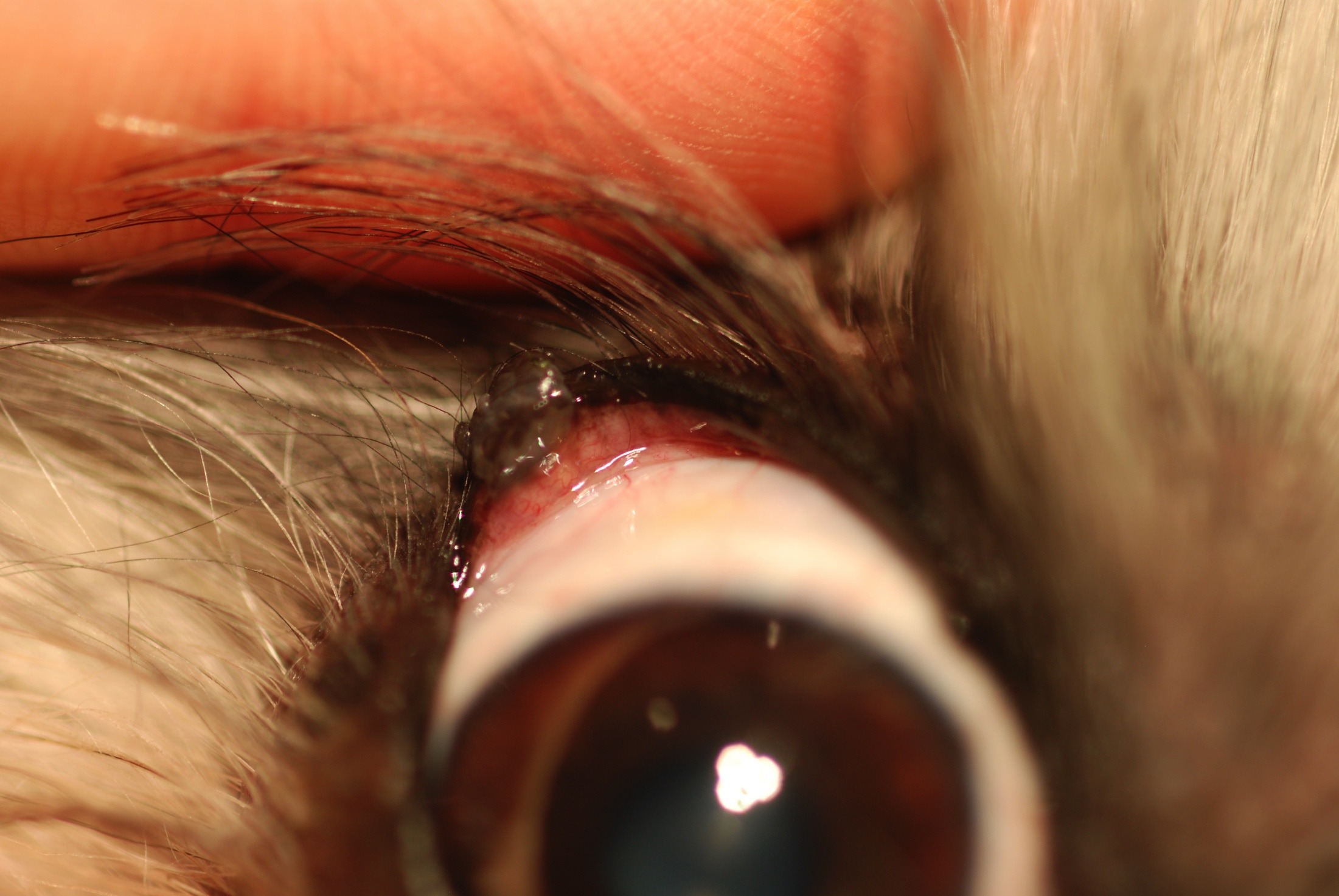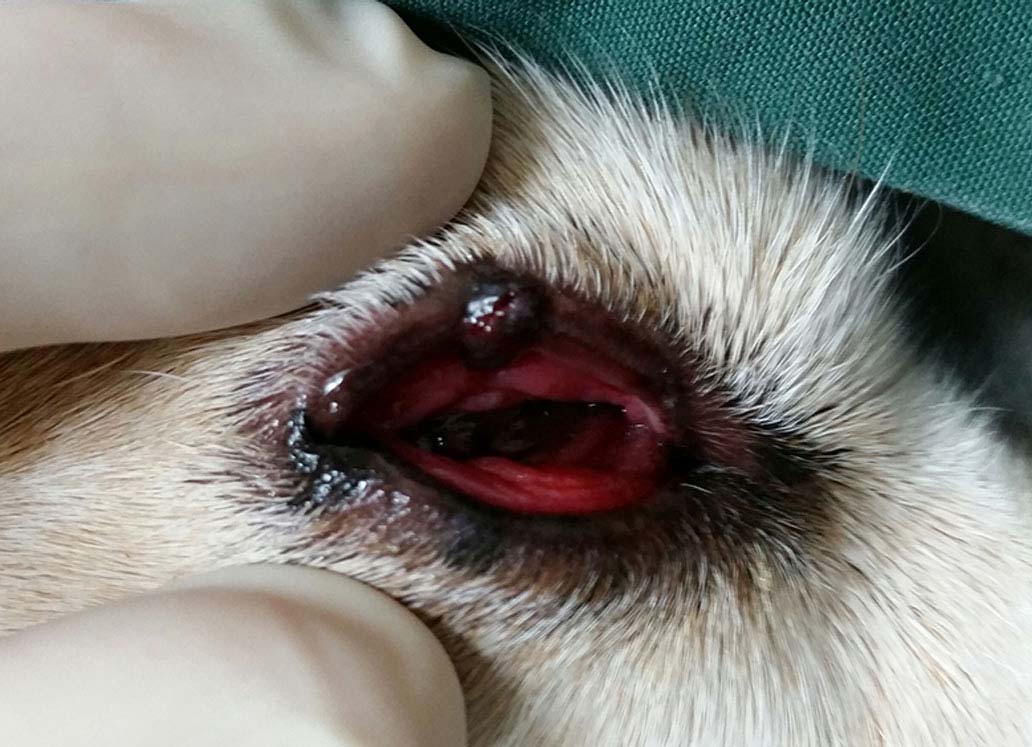
What are meibomian gland tumours. They occur more commonly in young dogs but can occur in dogs of any age.

The tear film protects the eye from particles dirt dust and it also helps to keep the eye moist.
Meibomian gland cyst dogs. Meibomian gland cysts in dogs are tiny little nodules that can form in whats known as the third eye. The third eye aka nictitating membrane is the tissue you see in the corner of the eye. If you watch your dog blink youll see movement of that membrane.
Will My Dog Go Blind. Meibomian cysts or tumors occur on or under the eyelid margin. If you notice a growth on your dogs eyelid it could be whats known as a meibomian gland cyst or chalazion.
Both dog and cat eyes may be affected by these but they are more common in dogs. Health Navigator says these are usually caused by blocked oil glands and they are not due to. Meibomian gland tumors are tiny slow-growing tumors that form in the meibomian glands of the eyelids.
Meibomian gland tumors in dogs are usually benign non-cancerous so they dont typically spread or move to other areas of the body. Canine meibomian gland tumors can become irritated painful and even infected or they can cause corneal ulcers or conjunctivitis. In dogs Meibomian gland tumors usually grow slowly.
These tumors are tiny slow-growing tumors that form in the meibomian glands of the eyelids. Meibomian glands are sebaceous glands that provide an oily secretion to stabilize the tear film over the cornea Common in older dogs meibomian gland tumors are usually benign but a small percentage of them are carcinomas that can metastasize into lymph nodes. What are meibomian gland tumours.
These are tumours of the meibomian glands of the eyelids. These are common in older dogs and start as small bumps at the margin of the upper and lower eyelids. Many of these stay small 2 - 3mm and do not continue to grow further so there is never any rush to have them removed.
Meibomian Cysts also known as eyelid cysts are growths on your dog or cats eyelids. It is more common in dogs than cats. They are usually caused by blocked oil glands.
Cancer of the eye. Lymphoma Melanoma and Neuroblastoma. Cancer of the eye in dogs and cats occur as tumors on the eye.
Meibomian glands produce sebum oil which helps keep the surface of the eye lubricated. Sebum prevents the evaporation of the dogs natural tear film. The tear film protects the eye from particles dirt dust and it also helps to keep the eye moist.
When the opening of the meibomian gland duct gets clogged the oil builds up in the gland and causes inflammation. Sebaceous adenitis and concurrent meibomian gland dysfunction MGD were diagnosed in a two-year-old mongrel dog presenting with hypotrichosis exfoliative dermatitis and blepharitis. Diagnosis of sebaceous adenitis was based on history clinical signs the histological demonstration of multifocal lymphohistiocytic and neutrophilic inflammation targeting the.
In Shih Tzus distichia occur in combination with an excessive accumulation of secretion within the meibomian glands. Ectopic cilia also arise from the Meibomian glands but emerge through the palpebral conjunctiva causing corneal irritation oftentimes even ulceration. They can occur in any breed.
However the Flat Coated Retrievers and some brachycephalic dogs Shih Tzu Pug. Eyelid tumors can occur in any breed at any age but older dogs tend to present to our service for evaluation. The most common types of tumors appear as neoplasia of the Meibomian gland the primary oil producing glands located in the eyelid margin.
Papilloma - pink or whitish benign lump which can occur in dogs of any age and usually have an irregular appearance. Cyst - these can occur usually in a meibomian gland where the gland becomes blocked swollen and filled with fluid. This type of cyst is often called a chalazion.
Meibomian adenoma is a common tumor in dogs being estimated at 50 of all ocular tumors. This tumor may resemble cutaneous sebaceous adenoma. Histological structure is specific for the meibomian gland with the presence of foamy lobules.
Eosinophilic sebaceous cells surround basal cells in the prominent part of the tumor. Meibomian gland tumors Meibomian gland adenomas ie benign tumors and adenocarcinomas ie malignant tumors comprise approximately 60 percent of the eyelid tumors seen in older dogs. These pink to pigmented lobulated masses arise from the meibomian glands that line the eyelid margins and may become ulcerated and bleed as they become.
Several breeds are known to be predisposed to this type of cancer. This tumor may affect any area of the skin the nosenasal planum or the toes. Fine needle aspiration or biopsy may be performed for diagnosis.
About 30 of dogs with the digital form of the disease will have evidence of spread. They are responsible for the supply of sebum which prevents the tear film from evaporating. Meibomian tumors are slow-growing and may contain an excessive amount of melanin.
These lesions too can be classified like sebaceous gland tumors. However these tumors are rare in dogs. Meibomian carcinoma is uncommon in dogs.
These masses are often viral in origin and they vary in color from white to pink to pigmented and tend to appear pedunculated and cobblestone-like in appearance. They occur more commonly in young dogs but can occur in dogs of any age. In young dogs they can regress without treatment.
Diagnosis Treatment and Prognosis. Meibomian gland dysfunction MGD is one of the possible conditions underlying ocular surface disorders OSD. Prevalence of MGD in dogs affected by OSD has not yet been reported.
We aimed to evaluate the prevalence of MGD among OSD canine patients which had been assessed by non-contact infrared meibography and interferometry and to identify MGD. Meibomian Gland Adenomas MGA are benign age related eyelid tumors which result from the accumulation of glandular material. If they become large enough MGAs can cause irritation to the cornea and conjunctiva and may reduce the normal ability to blink.
Cysts can also interfere with a dogs normal movement and impair them. A cyst on a paw pad leg or joint can interfere with their ability to walk. A cyst on an eyelid known as meibomian gland adenoma can interfere with their ability to blink or cause excessive blinking.
While most cysts are generally slow growing and arent harmful. The Spitz has a left lower eyelid tumour and a 1-cm lump in his belly. The eyelid tumour grows bigger over the past weeks causing the dog to rub against the.
An eight year old male Labrador dog had a history of swelling on the left eyelid for the past one month. Cytological evaluation revealed individual to cluster of pleomorphic neoplastic cells with foamy background. Histopathological examination revealed basaloid cells differentiating into polyhedral cells.
Cluster of cells showing anisocytosis and anisokaryosis with fatty cyst.